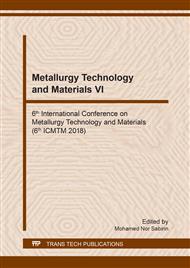[1]
R.A. Castleman. A hydrodynamics theory of piston ring lubrication, J. Physics. 7 (1936) 364-367.
Google Scholar
[2]
A. Ronen, I. Etsion. Friction-reducing surface-texturing in reciprocating automotive components, J. Tribology Transactions. 44 (2001) 359–366.
DOI: 10.1080/10402000108982468
Google Scholar
[3]
G.Ryk, Y. Elgerman, I. Etsion. Experimental Investigation of Laser Surface Texturing for Reciprocating Automotive Components, J. Tribology Transactions. 45 (2002) 444–449.
DOI: 10.1080/10402000208982572
Google Scholar
[4]
Y. Kligerman, A. Shinkarenko, I. Etsion. Improving Tribological Performance of Piston Rings by Partial Surface Texturing, J. Journal of Tribology. 127 (2005) 632.
DOI: 10.1115/1.1866171
Google Scholar
[5]
G. Ryk, Y. ligerman, I. Etsion, A. Shinkarenko. Experimental investigation of partial laser surface texturing for piston-ring friction reduction, J. Tribology Transactions. 48 (2005) 583–588.
DOI: 10.1080/05698190500313544
Google Scholar
[6]
I. Etsion, E. Sher. Improving fuel efficiency with laser surface textured piston rings J. Tribology International. 42 (2009) 542–547.
DOI: 10.1016/j.triboint.2008.02.015
Google Scholar
[7]
G. B. Gadeschi, K. Backhaus, G. Knoll. Numerical Analysis of Laser-Textured Piston-Rings in the Hydrodynamic Lubrication Regime, J. Journal of Tribology. 4 (2012) 41702.
DOI: 10.1115/1.4007347
Google Scholar
[8]
E. Tomanik. Modelling the hydrodynamic support of cylinder bore and piston rings with laser textured surfaces, J. Tribology International. 59 (2013) 90–96.
DOI: 10.1016/j.triboint.2012.01.016
Google Scholar
[9]
N. Morris, R. Rahmani, H. Rahnejat. Tribology of piston compression ring conjunction under transient thermal mixed regime of lubrication, J. Tribology International. 59 (2013) 248–258.
DOI: 10.1016/j.triboint.2012.09.002
Google Scholar
[10]
Z. Ma, N. A. Henein, W. Bryzik. A model for wear and friction in cylinder liners and piston rings, J. Tribology Transactions. 49 (2006) 315–327.
DOI: 10.1080/05698190600678630
Google Scholar
[11]
R. Rahmani, H. Rahnejat, B. Fitzsimons, D. Dowson. The effect of cylinder liner operating temperature on frictional loss and engine emissions in piston ring conjunction, J. Applied Energy. 191 (2017) 568–581.
DOI: 10.1016/j.apenergy.2017.01.098
Google Scholar
[12]
P. R. Yang, Q. Y. Chang. Thermal elasto hydrodynamic lubrication with ultra large sliding/ rolling ratios, J. Mechanical Engineering. 36 (2000) 31-34.
DOI: 10.3901/jme.2000.07.031
Google Scholar
[13]
P. R. Yang, P. R. Yang. A generalized Rynolds equation for non-newtonian thermal elastohydro- dynamic lubrication, J. ASME Journal of Tribology. 112 (1990) 631-636.
DOI: 10.1115/1.2920308
Google Scholar


